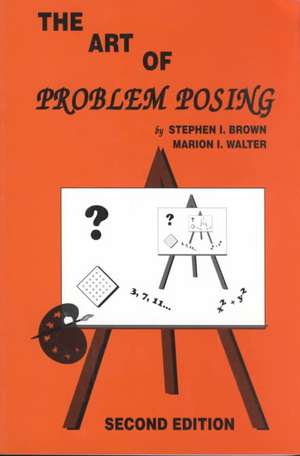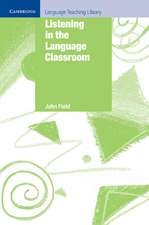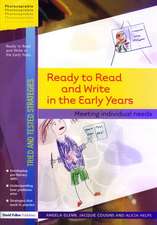The Art of Problem Posing
Autor Stephen I. Brown, Marion I. Walteren Limba Engleză Paperback – mar 1990
Special features include:
* an exploration ofthe logical relationship between problem posing and problem solving
* a special chapter devoted to teaching problem posing as a separate course
* sketches, drawings, diagrams, and cartoons that illustrate the schemes proposed
* a special section on writing in mathematics
| Toate formatele și edițiile | Preț | Express |
|---|---|---|
| Paperback (2) | 340.77 lei 43-57 zile | |
| Taylor & Francis – mar 1990 | 340.77 lei 43-57 zile | |
| Taylor & Francis – 7 dec 2004 | 359.68 lei 43-57 zile | |
| Hardback (2) | 983.38 lei 43-57 zile | |
| Taylor & Francis – apr 1990 | 983.38 lei 43-57 zile | |
| Taylor & Francis – 7 dec 2004 | 985.67 lei 43-57 zile |
Preț: 340.77 lei
Nou
Puncte Express: 511
Preț estimativ în valută:
65.24€ • 67.09$ • 54.12£
65.24€ • 67.09$ • 54.12£
Carte tipărită la comandă
Livrare economică 17 februarie-03 martie
Preluare comenzi: 021 569.72.76
Specificații
ISBN-13: 9780805802580
ISBN-10: 0805802584
Pagini: 160
Dimensiuni: 152 x 229 x 9 mm
Greutate: 0.23 kg
Ediția:Nouă
Editura: Taylor & Francis
Colecția Routledge
Locul publicării:Oxford, United Kingdom
ISBN-10: 0805802584
Pagini: 160
Dimensiuni: 152 x 229 x 9 mm
Greutate: 0.23 kg
Ediția:Nouă
Editura: Taylor & Francis
Colecția Routledge
Locul publicării:Oxford, United Kingdom
Public țintă
ProfessionalCuprins
Contents: Introduction. Two Problem Posing Perspectives: Accepting and Challenging. The First Phase of Problem Posing: Accepting. The Second Phase of Problem Posing: "What-If-Not." The "What-If-Not" Strategy in Action. Some Natural Links Between Problem Posing and Problem Solving. In the Classroom: Student as Author and Critic. Conclusion.
Notă biografică
Stephen I. Brown, Marion I. Walter
Recenzii
"The text is easy to read and actively involves the reader. The Art of Problem Solving has the potential to influence significantly the way teachers think about the nature of mathematics and what it means to 'do' mathematics. The authors invision that this will, in turn, influence mathematics students of all ages as they engage in solving problems they themselves have posed."
—Mathematics Teacher
"When first published in 1983,...provided an innovative approach to mathematics education and problem solving. The third edition features several new highlights, including computer examples that show how technology affects problem posing, discussion of the concept of student as author and critic, and analysis of how the 'standards' in math education incorporate problem-posing techniques."
—ED - Harvard Graduate School of Education
"The audience for this book is any college mathematics students, present and future teachers of mathematics, as well as any person interested in problem posing."
—School Science and Mathematics Journal
—Mathematics Teacher
"When first published in 1983,...provided an innovative approach to mathematics education and problem solving. The third edition features several new highlights, including computer examples that show how technology affects problem posing, discussion of the concept of student as author and critic, and analysis of how the 'standards' in math education incorporate problem-posing techniques."
—ED - Harvard Graduate School of Education
"The audience for this book is any college mathematics students, present and future teachers of mathematics, as well as any person interested in problem posing."
—School Science and Mathematics Journal
Descriere
Descriere de la o altă ediție sau format:
This book encourages readers to shift their thinking about problem posing from the "other" to themselves (i.e. that they can develop problems themselves) and offers a broader conception of what can be done with problems.
This book encourages readers to shift their thinking about problem posing from the "other" to themselves (i.e. that they can develop problems themselves) and offers a broader conception of what can be done with problems.


















